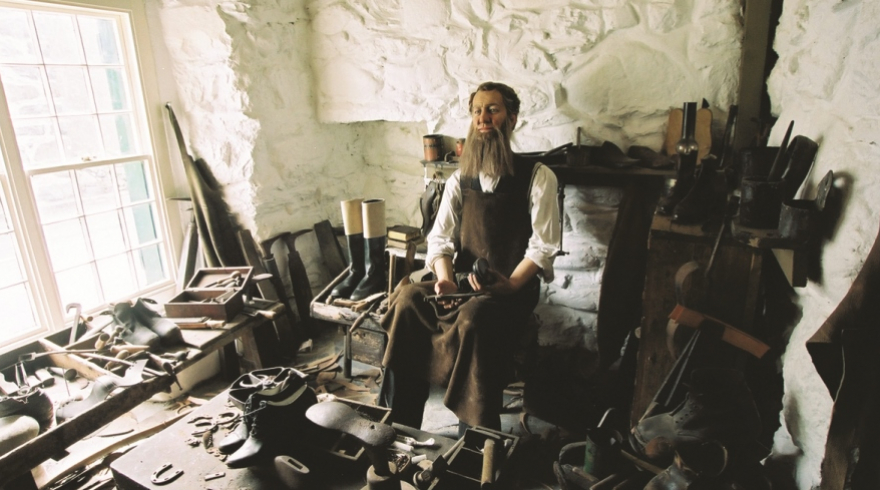Heritage and Culture
It’s what makes us different. Country and coast are peppered with a special mix of historic sites – World Heritage fortresses and slate quarries, Celtic shrines and cultural centres. There are inspirational landscapes too, and a living Welsh language you’ll hear and see everywhere. All these things have made North Wales what it is today – a unique part of the United Kingdom. It’s an identity we like to share with everyone, through words, music and new initiatives like Ein Treftadaeth (‘Our Heritage’) which brings the past to life in many different ways.
The Slate Landscape of Northwest Wales World Heritage Site

Slates wrenched from the mountains of Snowdonia not only roofed buildings in the four corners of the world, they also formed the unique landscape that we see today across north west Wales. Communities were created which became the hub of cultural and political life, helping to ensure the survival of the Welsh language. This rich heritage is designated an UNESCO World Heritage Site, Wales’ fourth World Heritage Site, thus acknowledging the slate industry’s contribution to the development of humanity. For more information visit Wales Slate.
Our Heritage
Our Heritage encompassing everything from prehistory to the coming of the Romans, pilgrims’ trails to the Princes of Gwynedd, spiritual landscapes to the slate industry. For further information go to the Our Heritage website.
Princes of Gwynedd
The mighty castles thrown up by English King Edward I are just part of our story. Discover more about the native Princes of Gwynedd at an exhibition in Conwy Tourist Information Centre, featuring animated and explorer maps, interactive displays, Welsh poetry and music. There are also hub exhibitions at Betws y Coed TIC, Cricieth Castle and Beddgelert TIC.
Bryn on Bardsey
Such is the power of Snowdonia’s landscapes that everyone, locals and visitors alike, can tune in. Here’s what local hero Bryn Terfel thinks of Ynys Enlli (Bardsey Island) off the tip of Llŷn: ‘(It’s) an extraordinary island… tiny, but truly magical, a place of contemplation. They say 20,000 saints are buried here, which I’m sure is true, because, my goodness, I’ve never known such spirituality… As we arrived, a choir of seals sang us into the bay.’
Slate and Stone
The North Wales slate industry tells a compelling story and is told at industrial heritage sites like Chwarel Hên Llanfair Slate Caverns (Llanfair), Corris Mine, Inigo Jones Slateworks (Penygroes), Llechwedd Slate Caverns (Blaenau Ffestiniog), the National Slate Museum (Llanberis) and the Sygun Copper Mine (Beddgelert). Stone crops up everywhere too, in castles and ancient Celtic settlements like Tre’r Ceiri on the rock-strewn summit of Llŷn’s Yr Eifl mountains. Castles are something of a local speciality. Mighty Caernarfon, Harlech and Conwy – three UNESCO World Heritage Sites – are links in the medieval ‘iron chain’ built by Edward I.
National Slate Museum
Llanberis’s National Slate Museum brings to life an industry that once ‘roofed the world’. This is no ordinary museum. It’s the actual 19th-century workshops, looking as if the workers have just clocked off for the day. There’s also a row of quarrymen’s cottages and giant waterwheel. Little wonder that it’s a focal point for the slate industry’s bid for World Heritage status.
The National Trust
The National Trust cares for mansions and historic houses large and small – for example, Bangor’s neo-baronial Penrhyn Castle and humble Tŷ Mawr Wybrnant, Penmachno, home of Bishop William Morgan, who first translated the Bible into Welsh.
Words and Music
This lyrical language of ours is music to the ears. For more Celtic melodies and the chance to take part in interactive exhibitions go to Tŷ Siamas, Dolgellau, the National Centre for Folk Music. And for the written word there’s Tŷ Newydd, the National Writers’ Centre for Wales, at Llanystumdwy.
People and Places
Fiery politician Lloyd George who became Prime Minister had a peaceful upbringing in the village of Llanystumdwy – visit the museum there dedicated to the charismatic ‘Welsh Wizard’. The unique fantasy village of Portmeirion, where Italy meets North Wales, was the vision of one man – architect Sir Clough Williams-Ellis. Go there and be amazed. Kate Roberts (1891–1985) is one of Wales’s most celebrated writers. Discover more about her life and work at the heritage centre in her childhood home, Cae’r Gors, Rhosgadfan.
Cadw
Cadw meaning ‘to keep’ or ‘to protect’ is the Welsh Government’s historic environment service, responsible for the care of many historic sites such as Plas Mawr, Conwy, and major castles. Download the latest version of the App.
Local history on your smartphone
Look out for the green HistoryPoints logo on walls, fences, and windows. Scan the QR codes with an App on your mobile or tablet and discover the story of the object or landscape in front of you.






